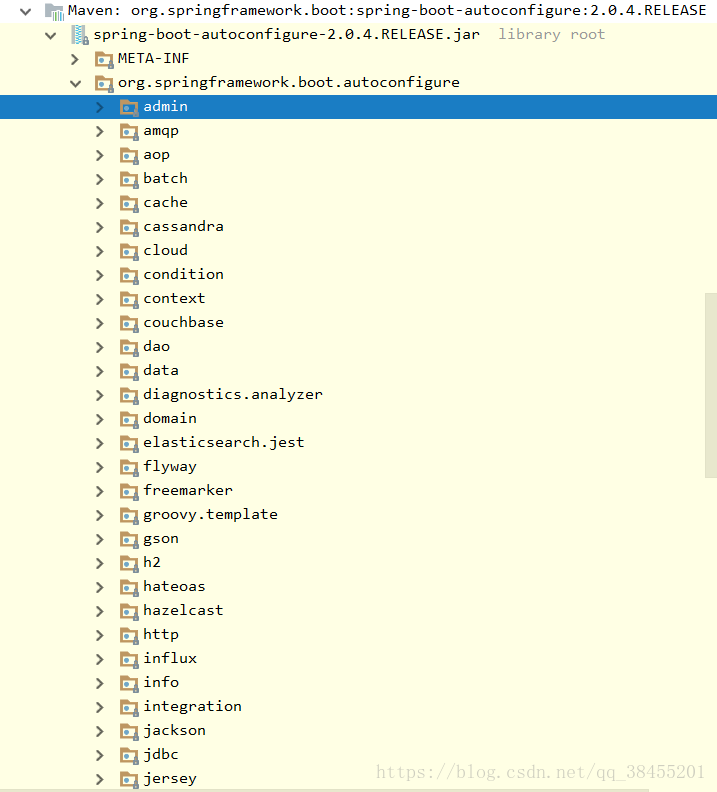(五)Spring Boot配置篇 之 自动配置实现原理
我们在使用Spring Boot构建Java Web项目的时候,实现起来非常的简单,那么SpringBoot是如何做到看似简单,却能够实现我们之前使用SSM或者SSH结合复杂配置实现的功能的呢?
我们在看Spring Boot的介绍的时候,常看到下面一段话:Spring Boot 是由 Pivotal 团队提供的全新框架,其设计目的是用来简化新 Spring 应用的初始搭建以及开发过程。该框架使用了特定的方式来进行配置,从而使开发人员不再需要定义样板化的配置。Spring Boot采用约定大约配置的方式,大量的减少了配置文件的使用。那么,Spring Boot是如何做到约定大于配置的呢?
首先我们看一下Spring Boot的主程序功能,也就是Spring Boot官方文档里面写的,你可以直接run
@SpringBootApplication
public class Application {
public static void main(String[] args) {
SpringApplication.run(Application.class, args);
}
}
一个非常简单的run方法的执行,加上@SpringBootApplication的注解,我们看一下run方法的源代码:
public class SpringApplication{ ...... public ConfigurableApplicationContext run(String... args) { //监控任务执行时间 StopWatch stopWatch = new StopWatch(); stopWatch.start(); //创建应用上下文 ConfigurableApplicationContext context = null; //用来记录关于启动的错误报告 Collection<SpringBootExceptionReporter> exceptionReporters = new ArrayList<>(); configureHeadlessProperty(); //可以监听springboot应用启动过程中的一些生命周期事件 SpringApplicationRunListeners listeners = getRunListeners(args); listeners.starting(); try { //程序运行参数 ApplicationArguments applicationArguments = new DefaultApplicationArguments( args); //加载相关的配置文件 ConfigurableEnvironment environment = prepareEnvironment(listeners, applicationArguments); configureIgnoreBeanInfo(environment); //打印Banner,也就是springboot启动后最开始打印的图像 Banner printedBanner = printBanner(environment); //真正的创建应用上下文 context = createApplicationContext(); exceptionReporters = getSpringFactoriesInstances( SpringBootExceptionReporter.class, new Class[] { ConfigurableApplicationContext.class }, context); prepareContext(context, environment, listeners, applicationArguments, printedBanner); refreshContext(context); afterRefresh(context, applicationArguments); stopWatch.stop(); if (this.logStartupInfo) { new StartupInfoLogger(this.mainApplicationClass) .logStarted(getApplicationLog(), stopWatch); } listeners.started(context); callRunners(context, applicationArguments); } catch (Throwable ex) { handleRunFailure(context, ex, exceptionReporters, listeners); throw new IllegalStateException(ex); } try { listeners.running(context); } catch (Throwable ex) { handleRunFailure(context, ex, exceptionReporters, null); throw new IllegalStateException(ex); } return context; } ...... }
在上面这段run方法的源代码当中,有一个context = createApplicationContext();方法
protected ConfigurableApplicationContext createApplicationContext() { Class<?> contextClass = this.applicationContextClass; if (contextClass == null) { try { switch (this.webApplicationType) { case SERVLET: //假如是servlet应用,默认加载DEFAULT_WEB_CONTEXT_CLASS contextClass = Class.forName(DEFAULT_WEB_CONTEXT_CLASS); break; case REACTIVE: contextClass = Class.forName(DEFAULT_REACTIVE_WEB_CONTEXT_CLASS); break; default: contextClass = Class.forName(DEFAULT_CONTEXT_CLASS); } } catch (ClassNotFoundException ex) { throw new IllegalStateException( "Unable create a default ApplicationContext, " + "please specify an ApplicationContextClass", ex); } } return (ConfigurableApplicationContext) BeanUtils.instantiateClass(contextClass); }
也就是说,通过一个简单的run方法,将引发的是一系列复杂的内部调用和加载过程,从而初始化一个应用所需的配置、环境、资源以及各种自定义的类。在这个阶段,会导入一些列自动配置的类,实现强大的自动配置的功能。那么自动配置类是从哪里来的呢?这就需要@SpringBootApplicaton起到作用了。
@Target(ElementType.TYPE) @Retention(RetentionPolicy.RUNTIME) @Documented @Inherited @SpringBootConfiguration @EnableAutoConfiguration @ComponentScan(excludeFilters = { @Filter(type = FilterType.CUSTOM, classes = TypeExcludeFilter.class), @Filter(type = FilterType.CUSTOM, classes = AutoConfigurationExcludeFilter.class) }) public @interface SpringBootApplication { ...... }
其中,@ComponentScan将扫描和加载一些自定义的类,@EnableAutoConfiguration将导入一些自动配置的类。这些自动配置的类很多,并且他们都处于org.springframework.boot.autoconfigure这个包下面。这些配置类都会被导入并处于备用状态。假如你在maven文件当中引入了相关的包的时候,相关功能将被启用。

那么,我们说的springboot约定大于配置是什么意思呢?自动配置在加载一个类的时候,会首先去读取项目当中的配置文件,假如没有,就会启用默认值,这就是springboot约定大于配置原理。以Thymeleaf为例:看下下面我们就知道,为什么我们使用Thymeleaf模板引擎,html文件默认放在resources下面的templates文件夹下面,因为这是Thymeleaf的默认配置。
@ConfigurationProperties(prefix = "spring.thymeleaf") public class ThymeleafProperties { private static final Charset DEFAULT_ENCODING = StandardCharsets.UTF_8; public static final String DEFAULT_PREFIX = "classpath:/templates/"; public static final String DEFAULT_SUFFIX = ".html"; private boolean checkTemplate = true; private boolean checkTemplateLocation = true; private String prefix = DEFAULT_PREFIX; private String suffix = DEFAULT_SUFFIX; private String mode = "HTML"; private Charset encoding = DEFAULT_ENCODING; private boolean cache = true; ...... }
并且这些约定的配置一般都以Properties为结尾,比如
org.springframework.boot.autoconfigure.jdbc.DataSourceProperties(数据库连接配置)
org.springframework.boot.autoconfigure.data.redis.RedisProperties(Redis连接配置)
org.springframework.boot.autoconfigure.amqp.RabbitProperties(RabbitMQ连接配置)
org.springframework.boot.autoconfigure.web.ResourceProperties(Web资源配置)
org.springframework.boot.autoconfigure.kafka.KafkaProperties(Kafka连接配置)
org.springframework.boot.autoconfigure.cache.CacheProperties(缓存配置)
那么,我们知道程序会自动装配加载很多类,但是我们假如不想程序去加载某些类(毕竟加载需要耗时),我们如何去自定义我们想加载的配置类呢?
我们只需要把@SpringBootApplication注解去掉,换成@Congfiguation注解,并通过@Import注解去指定需要加载的配置类就可以了(非常不建议这么做,因为我们可能不是特别了解所有自动加载的类的特性)。
@Configuration @Import({ DispatcherServletAutoConfiguration.class, HttpEncodingAutoConfiguration.class, ThymeleafAutoConfiguration.class, WebMvcAutoConfiguration.class, WebSocketServletAutoConfiguration.class, MultipartAutoConfiguration.class //继续加载你需要的配置 }) public class Application { public static void main(String[] args) { SpringApplication.run(Application.class, args); } }




 浙公网安备 33010602011771号
浙公网安备 33010602011771号